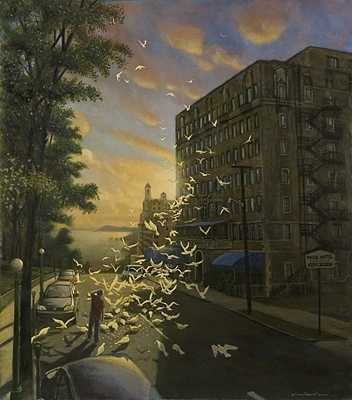
|
||||
|
national success in his ventures as an artist |
||||
|
Look at a painting and in many cases you'll
imagine a story behind the image. Most artists admit that each
of their works is telling a tale. Warren Criswell does, but he
also admits he'd rather not tell anyone what's going on in any
of his painted images. |
Warren Criswell of Benton holds a steady hand as he completes his latest work. |
|||
| "We
were road hippies," he said. "I was traveling around
with my wife, Janet, and our two daughters in a bus, looking
for some place to 'homestead.' I was writing for a living at
the time, so I didn't need a permanent address. But my main publisher
went out of business when we were in Ohio, which left us living
on food stamps and road kill, so we figured we'd better head
south for the winter. I was also researching a sci-fi novel involving
global warming and the melting of the ice caps. If that happened,
which it does in the story, it would flood the Mississippi basin
up to about 50 feet above current sea level. I looked at a contour
map and found that Little Rock would be on or under the new sea
coast, a good setting for the novel. I needed to see the place
for myself, so we headed down here. It was the last place the
bus broke down. We liked Arkansas and finally got our piece of
land in the woods." Before the Arkansas breakdown or the bus adventure that led to it, Criswell had lived and painted in his hometown of West Palm Beach, Fla. He'd established himself as an artist by the early 1960s, but eventually burned out on the "gallery scene." After working as a land surveyor for five years, he turned to writing and made a career of it until he began to find it unsatisfying. "I had some shows in Palm Beach but the gallery politics drove me away from it," he said. "I wrote for our money after we started our bus odyssey, but Janet took over the writing and I returned to painting like a salmon to the spawning bed. But I couldn't have done it without her. My advice to aspiring artists is always the same: Find somebody who loves you enough to support you." In the late 1970s, Criswell began showing his art in Arkansas. Some of his earliest displays were in Little Rock's Cantrell Gallery, which, along with Taylor's Contemporanea, represent him today. While most recognized for his painting, Criswell is also a sculptor and printmaker. "I don't have ideas so much, in the intellectual sense, as images. I refer to it as being ambushed. I'll just be driving down the street or walk into the kitchen and see something I've seen hundreds of times before, and it will suddenly click as an image, something I see as a painting." Many of Criswell's paintings are obviously telling a story, though he claims that, sometimes, he tries to get away from that. "I started doing a lot of still lifes," Criswell said, "which I thought of as a big break from narrative paintings. I thought I was painting 'the things themselves,' as Husserl said. But people would look at these things and immediately read stories into them. So I had to conclude that every image is a narrative, it's just the way our minds work. Viewing a painting should be a personal experience. I love it when people look at my work and come up with a totally different idea about what's happening than the one I had. It's good to know that the art works on different levels, and that people can have their own unique experience with it." Criswell's work is varied and does indeed spark the imagination. Bits and pieces of modern life make their way into the renderings quite often (the author noted that digital clocks regularly appear), and the work has a way of presenting mundane or everyday scenes in an almost surreal manner. Criswell also does nudes, or, as he prefers, "naked people." Anyone wishing to sample some of his artwork can do so at www.warrencriswell.com. Those wishing to see the actual paintings rather than electronic reproductions have many options. In addition to the work he has on display at the Cantrell Gallery and Taylor's Contemporanea in Hot Springs, he has work in the permanent collections at the Arkansas Art Center, UALR, UCA, Hendrix College and in the Central Arkansas Library System. Much of what Criswell has produced has a certain dark element to it, something the artist freely admits. "The creative process itself is pretty dark," he said. "Each painting is a high, but instead of the joyous, life-affirming experience that a lot of artists talk about, for me the high is pretty traumatic. Art is an addiction. If you try to stop you get withdrawal pains. The difference between art and other kinds of addictions is that the only thing worse than having it is not having it." After looking at what Criswell has produced in the throes of addiction, one can only hope that he'll never kick the habit. |
||||
|
|
||||

